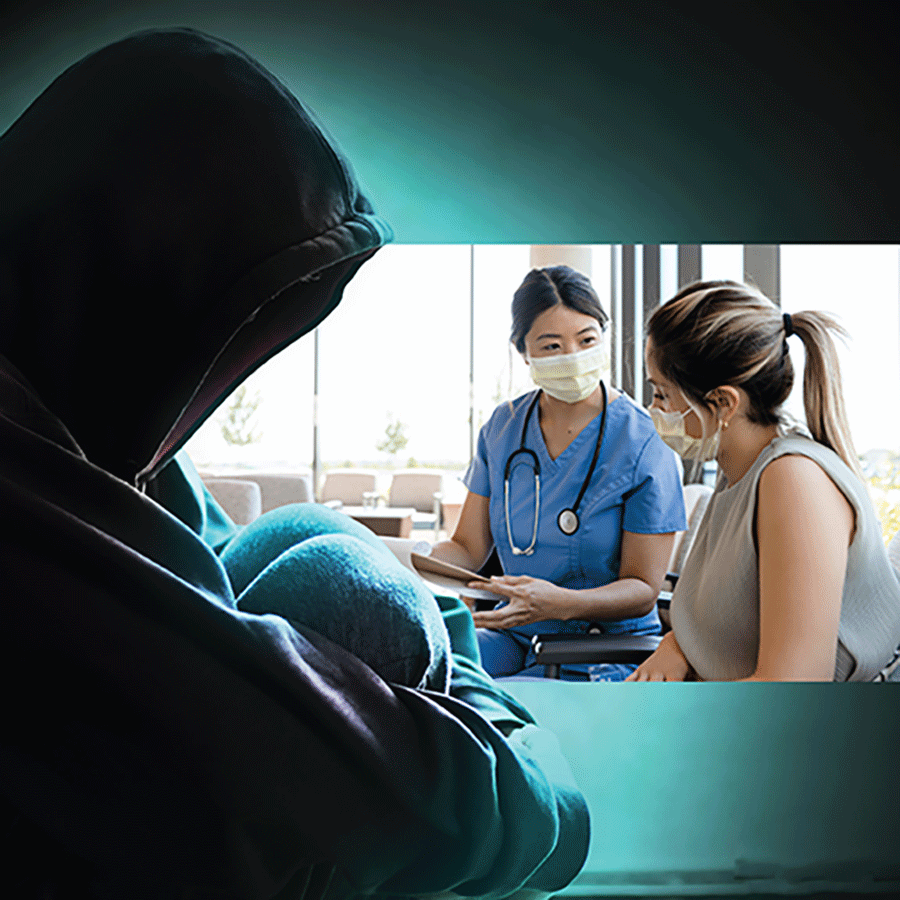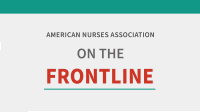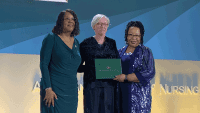Nurses play key role in recognizing, responding to patients in exploited circumstances
Human trafficking, a crime involving the exploitation of a person for labor, services, or commercial sex, ranks second only to drug trafficking as a global criminal enterprise. The tentacles of this nefarious activity reach across continents and venues—extending even into healthcare. This might come as a surprise to many nurses, who believe they’ve never encountered a person victimized by trafficking.
“With globalization and ease of travel, it’s a worldwide problem, but we nurses tend to think, ‘It’s not in our hospital. We’re in a civilized community, a civilized society.’ But if we become aware of some subtle signals, we’ll find it’s there,” said Joop Breuer, RN, FAEN, co-author of the Emergency Nurses Association (ENA) and International Association of Forensic Nurses joint position statement, Human Trafficking Awareness in the Emergency Care Setting. A charge nurse at Leiden University Medical Centre in the Netherlands, Breuer also serves on the board of directors of ENA, an organizational affiliate of the American Nurses Association (ANA).


Nurses in a wide range of practice settings likely have already interfaced with patients ensnared in trafficking, or will do so, according to Breuer and other experts. “No nurse is immune to encountering someone who might be in a trafficking situation, and nurses need to be equipped and prepared to respond appropriately within their scope of practice,” said Jessica Peck, DNP, APRN, CPNP-PC, CNE, CNL, FAAN, FAANP, a Texas Nurses Association member and clinical professor at the Louise Herrington School of Nursing at Baylor University in Dallas.
In healthcare, nurses aren’t alone in lacking awareness of trafficking. As many as 87% of victimized individuals may have had contact with a healthcare provider, but just a scant fraction of suspected cases gets reported. For example, in 2020, the National Human Trafficking Hotline received reports of more than 19,000 potential trafficking victims, but only 1,600 came from healthcare and behavioral health professionals.
Legal, ethical guidance
The Trafficking Victims Protection Act of 2000 first defined trafficking as a federal crime, but in the 2 decades since, awareness and action in healthcare has lagged. The Child Abuse Prevention and Treatment Act of 1974 and subsequent amendments and reauthorizations clearly link sex trafficking in children with child abuse and child sexual abuse, with mandated reporting requirements. In the case of adults, however, with no universal screening tool or protocol and a patchwork of state laws regarding mandated reporting, knowledge of individual nurses and indeed, institutions, leaves considerable room for improvement. Some states have enacted education requirements for healthcare providers about trafficking; Texas is the only one to have established standards for that training, according to Peck, who was recognized in 2022 with the ANA Advocacy Award for her leadership in anti-human trafficking.
Several provisions of the Code of Ethics for Nurses with Interpretive Statements (the Code) oblige nurses to report suspected trafficking, according to Linda Olson, PhD, RN, NEA-BC, FAAN, a member of the Illinois Nurses Foundation Board of Directors and a past member of the ANA Center for Ethics and Human Rights Advisory Board. Provision 1 of the Code states that nurses practice with compassion and respect for the inherent dignity, worth, and unique attributes of every person. Meanwhile Provision 2 states that a nurse’s primary commitment is to their patient, and Provision 3 states that nurses promote, advocate for, and protect the rights, health, and safety of their patients. Finally, Provision 8 states that nurses collaborate with other health professionals and the public to protect human rights and that they “bring attention to human rights violations in all settings and contexts.”
Suspending stereotypes
Healthcare providers might have an image of what people experiencing trafficking look like or how they present for care, but Peck and others urged nurses to set aside these stereotypes. Pop culture might draw a picture of a white female enslaved in sex trafficking who seeks care in an emergency setting and gives secret signals asking to be rescued. In reality, victimization worldwide spans persons of all genders and sexes, disproportionately affects people of color, targets more people for forced labor than sex trafficking, and frequently renders individuals terrified to disclose their status. Patients caught in trafficking show up in all kinds of healthcare settings, including emergent and primary care, dental care, and surgery. They might seek treatment for not only sexually transmitted infections and genitourinary injuries, but also burns, fractures, heat exhaustion, cosmetic procedures, mental health, and more.
Subject matter experts emphasized that no single red flag would alert a nurse that a patient potentially is subject to trafficking, but rather a patient’s overall clinical picture, and a nurse’s gestalt about that picture. “Recognition of human trafficking builds on experience nurses already have, and an instinct to pick up when something isn’t right that makes them concerned for their patient’s safety,” said Candace Rich, MSN, RN, CPNP, co-founder and director of operations for Reclaim611, a nonprofit that provides training and resources to help healthcare professionals recognize and report human trafficking.
Red flags include a patient who: can’t provide their address or identification, is inappropriately dressed for the weather, has a companion who answers all questions or hovers near the exam room, or reports being of adult age but responds as someone developmentally younger. These patients also could be drug- or alcohol-dependent and show signs of physical abuse or emotional abuse. More red flags should heighten nurses’ concerns.


Because of an exploited person’s vulnerabilities, not only in their present circumstances but also in the act of revealing their situation, Patricia M. Speck, DNSc, CRNP, FNP-BC, AFN-C, DF-IAFN, FAAFS, DF-AFN, FAAN, professor and coordinator of the advanced forensic nursing program at the University of Alabama School of Nursing in Birmingham, implored nurses to use trauma-informed care principles in their patient assessments and interactions. “A victimized patient may lose their life because of their healthcare encounter. So, we have to set aside our judgments and see the patient in front of us as a person with similar needs and goals, hopes and dreams,” she emphasized. This includes making a respectful overture to the patient, seeking permission to ask sensitive questions about their safety.
Speck, president of the Forensic Nursing Certification Board and coauthor of the American Academy of Nursing Council for the Advancement of Nursing Sciences policy brief on the nursing response to human trafficking, cautioned that treating a patient who is a trafficking victim could surface a nurse’s own traumatic experiences or expose them to vicarious or secondary trauma.
Core Competencies for Human Trafficking Response in Health Care and Behavioral Health Systems issued by the National Human Trafficking Training and Technical Assistance Center identifies trauma-informed care as a universal competency. This document also cites six core competencies, including nature and epidemiology, risk, needs evaluation, patient-centered care, legal/ethical standards, and prevention. Peck served as the nursing representative on the expert panel that developed these competencies.
Establishing trust
Because the stakes are so high for exploited individuals, they might be fearful of and even resistant to disclosing their status and asking for help, making it incumbent on nurses to approach them carefully and cautiously. “Nurses are in a trustworthy profession, and we have a confidential relationship with these patients,” observed Carrie Schirato, MSN, RN, FNP-C, ANCP-C, co-founder and executive director of Reclaim611. “Those two things give us a unique opportunity to talk to a patient and potentially make them feel safer to talk to us than other people in the community.”


Respect and openness are the bedrock of nurses’ interactions with patients who might be ensnared in trafficking, according to Emilie Kreilkamp, BSN, RN, CPN, a critical care float nurse at Children’s Wisconsin in Milwaukee and chair of the Wisconsin Nurses Association Anti-Human Trafficking Task Force. “You want to create that trusting relationship with them, be diligent and observant, and be the caring and trusting health professionals that we are,” she said.
Schirato added that nurses are in an exceptional position to get support for survivors’ immediate needs—not only medical, but also social (housing and food), and legal services. “We have a platform that literally nobody else has,” she emphasized.
Building a victim’s trust so they will disclose their circumstances typically doesn’t happen in a single encounter. For this reason, Olson urged nurses to thoroughly document their objective observations so subsequent providers who interact with a suspected victimized person will be aware of this as a possibility.
Building institutional supports
Nurses also need institutional systems and supports to act on behalf of victims—resources that might not be in place. In Schirato’s and Rich’s experience, a health system might offer a single training session, but not take additional steps to implement protocols and tools for risk and safety assessments, trauma-informed care, a safety plan for the survivor, and chain-of-command notifications.
“Hospitals are approaching human trafficking as this internal and inoculated issue when it’s extremely complex,” Schirato said. She added that health systems tend to appoint a task force of staff members who are passionate about the topic but may not have the knowledge or authority necessary to implement best practices. Breuer also stressed that protocols should extend beyond healthcare organizations. “There needs to be a system-wide approach, not only a hospital or law enforcement approach, but an integrated approach,” he said.
As major health systems up their game with anti- trafficking policies and protocols, Peck noted, a trend has emerged in which victimized persons and their traffickers present at facilities in rural or underserved areas that might not have developed those responses, making it less likely they’ll be detected. “It’s really important that everyone is equipped and prepared because trafficking can show up anywhere in any health system,” she observed.
Both Schirato and Rich emphasized the importance of a team approach to anti-trafficking efforts. For example, Rich recalled a case in which a security guard who had undergone anti-trafficking training noticed while working in an emergency department that the person checking in a patient had kept the patient’s identification, along with other red flags. The guard, following the institution’s protocol,
notified emergency department providers, setting
in motion a response that led to the patient being safely removed from trafficking.
A team approach also could ease the response load on nurses, perhaps better enabling them to act on their observations. “The benevolence, caring, and compassion are there, but many nurses today are operating on such a low reservoir of energy and to take on one of these very difficult cases takes time. It’ll keep you from going home on time, so we may have blinders on as to a patient’s situation,” Speck said.
Peck underscored the hazards of nurses attempting to intervene in a suspected trafficking situation when they lack sufficient training or institutional support. “Oftentimes nurses feel moral distress when they encounter someone who’s been trafficked and they feel like they have to solve all of their problems,” she observed. “It’s not the responsibility of nurses to rescue patients. That’s a harmful narrative and unfair burden to put on nurses.”
She and others stressed the need for nurses foremost to obtain evidence-based education. From there, acting together, they can prompt health systems to marshal resources and protocols for a more comprehensive, effective response by all. As Speck concluded, “Nursing has the key.”
Genna Rollins is a writer/editor at the American Nurses Association
Resources
HEAL Trafficking (healtrafficking.org)
Human Trafficking Search (humantraffickingsearch.org)
American Hospital Association: Legal requirements for reporting and education for human trafficking and health care providers (bit.ly/3JQpM7t)
Office on Trafficking in Persons: SOAR to health and wellness training (acf.hhs.gov/otip/training/soar-health-and-wellness-training)
Office on Trafficking in Persons: Report: Core competencies for human trafficking response in health care and behavioral health systems (bit.ly/3HBtgb2)
Reclaim611 (reclaim611.org)
Partners for Vulnerable Youth: Provider & public resources (napnappartners.org/provider-public-resources)
Polaris (polarisproject.org)




















